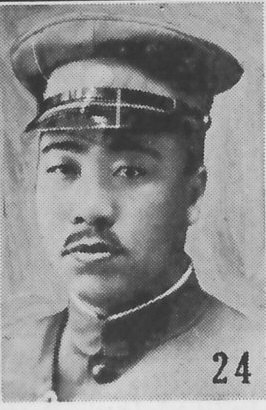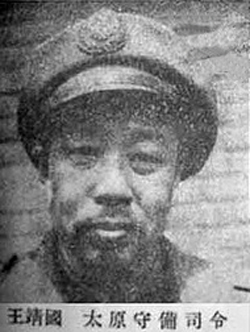Wang Jingguo on:
[Wikipedia]
[Google]
[Amazon]

 Wang Jingguo (, 1893–1949) was a
Wang Jingguo (, 1893–1949) was a

 Wang Jingguo (, 1893–1949) was a
Wang Jingguo (, 1893–1949) was a KMT
The Kuomintang (KMT), also referred to as the Guomindang (GMD), the Nationalist Party of China (NPC) or the Chinese Nationalist Party (CNP), is a major political party in the Republic of China, initially on the Chinese mainland and in Tai ...
general from Shanxi. He was the son-in-law of the warlord who controlled Shanxi from 1911–1949, Yan Xishan
Yan Xishan (; 8 October 1883 – 22 July 1960, ) was a Chinese warlord who served in the government of the Republic of China. He effectively controlled the province of Shanxi from the 1911 Xinhai Revolution to the 1949 Communist victory in ...
. Wang served throughout his career in Yan's army, fighting in numerous campaigns.
Military service
Suiyuan
In 1936 units under Wang's command were sent to reinforce theInner Mongolia
Inner Mongolia, officially the Inner Mongolia Autonomous Region, is an autonomous region of the People's Republic of China. Its border includes most of the length of China's border with the country of Mongolia. Inner Mongolia also accounts for a ...
n province of Suiyuan
Suiyuan () is a ''de jure'' province of the Republic of China according to the ROC law, as the ROC government formally claims to be the legitimate government of China, with its capital located Guisui (now Hohhot). The abbreviation was ( pinyi ...
, which Yan controlled. Wang's orders were to defend against an attack by the Japanese puppet army of Mengguguo, led by Prince Teh (Demchugdongrub). Wang's senior commander in defending Suiyuan was Fu Zuoyi
Fu Zuoyi () (June 2, 1895 − April 19, 1974) was a Chinese military leader. He began his military career in the service of Yan Xishan, and he was widely praised for his defense of Suiyuan from the Japanese. During the final stages of the Chi ...
, who was also an officer of Yan's. In the subsequent battle with Mengguguo, Prince Teh's forces were virtually annihilated, and Prince Teh lost all areas in Suiyuan and Chahar which were not under the immediate protection of the Japanese Kwantung Army
''Kantō-gun''
, image = Kwantung Army Headquarters.JPG
, image_size = 300px
, caption = Kwantung Army headquarters in Hsinking, Manchukuo
, dates = April ...
.
Second Sino-Japanese War
When the Japanese invaded Shanxi in 1937, Yan Xishan requested, and received, military aid from the Communist People's Liberation Army, which entered Shanxi and set up operations in much of the province. By late 1938 Yan had become afraid of the rapid power and influence that the Communist forces operating in Shanxi quickly gained, and this fear caused Yan to become increasingly hostile to Communist agents and soldiers. In order to combat the spread and influence of communism within Yan's armies and in the area that Yan controlled, Wang Jingguo persuaded Yan to establish a "National Revolutionary Comrades Association", a paramilitary organization that existed to identify and persecute Communists in Yan's territory and in the army. The actions of this Association eventually contributed to the destruction of all cooperation between Yan and the Communists in the winter of 1939. From 1939-1945 Yan was successful in keeping his territory free from Communist influence and activity.Chinese Civil War
By 1948 all Nationalist forces in China, including Yan Xishan's forces, were being rapidly defeated by Chinese Communist armies. In March 1948 Yan himself was airlifted out of Taiyuan, taking most of the provincial treasury with him, apparently for the purpose of asking the central government to send more supplies and materiel to Yan's surrounded forces. Yan did not return. Wang Jingguo was left in charge of much of Yan's remaining forces, including all Nationalist reinforcements left stranded in Taiyuan. Wang's direct superior was a Japanese officer who had joined Yan's army after World War II,Imamura Hosaku
Imamura Hōsaku (Japanese: 今村方策, January 4, 1900 – April 24, 1949) was a Japanese military officer in the Kwantung Army who was most notable for staying on in China after the surrender of Japan on August 15, 1945. He and many of his fello ...
, who continued to direct the resistance. In April, 1949, the Communists launched a final attack against Taiyuan's last defenders that included over 1,300 pieces of artillery and a force three times larger than the defenders. After Taiyuan fell, Wang Jingguo was captured. He was last seen in public being led through the streets at the end of a rope.Gillin 288
Footnotes
References
* Gillin, Donald G. ''Warlord: Yen Hsi-shan in Shansi Province 1911-1949''. Princeton, New Jersey: Princeton University Press. 1967. {{DEFAULTSORT:Wang Jingguo National Revolutionary Army generals from Shanxi People from Xinzhou 1893 births 1952 deaths Chinese anti-communists